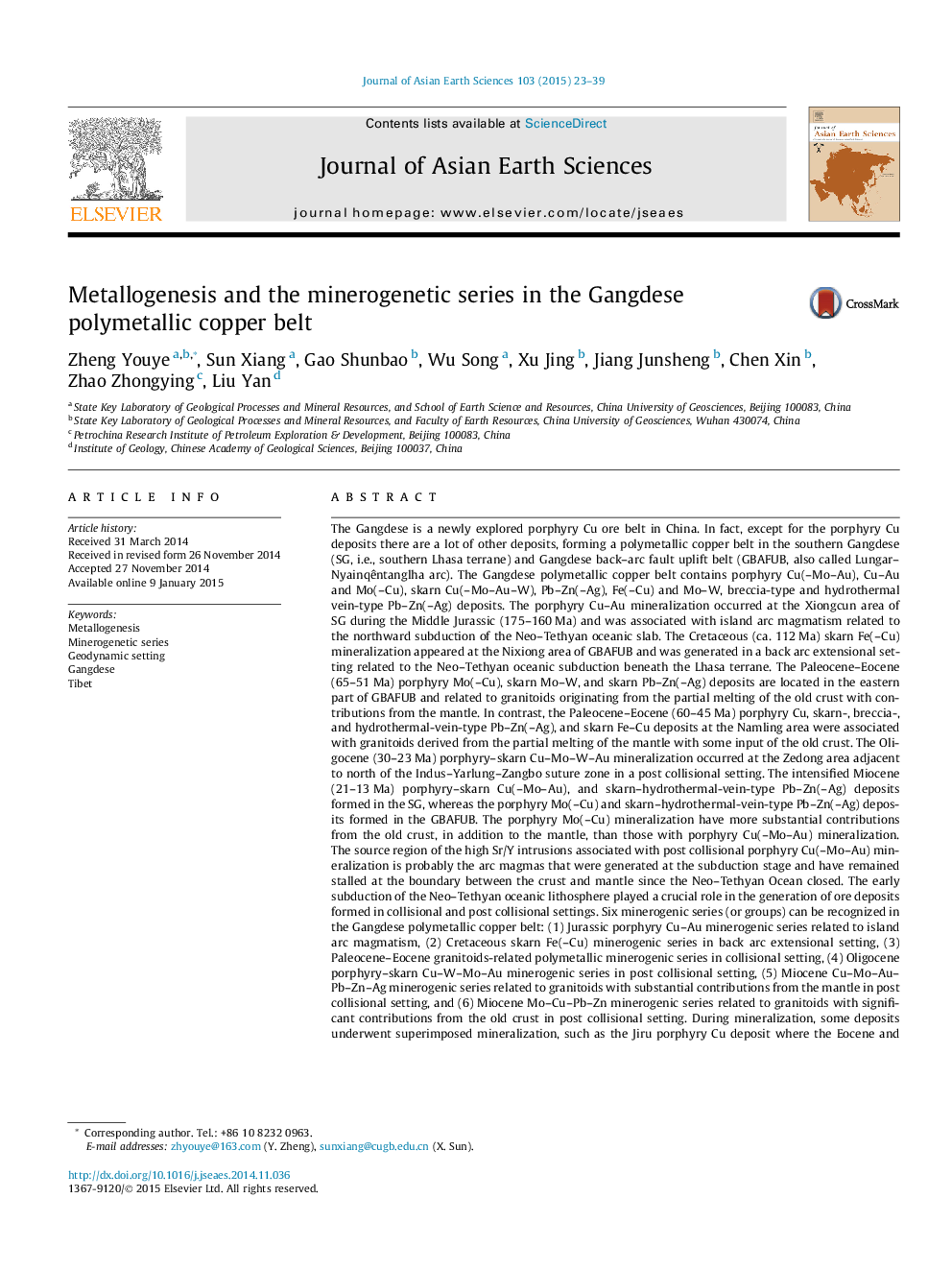| Article ID | Journal | Published Year | Pages | File Type |
|---|---|---|---|---|
| 4730348 | Journal of Asian Earth Sciences | 2015 | 17 Pages |
•Types of ore deposits in the Gangdese belt were documented.•Seven minerogenetic series took place in the Gangdese belt from Jurassic to Miocene.•The relationship between porphyry Cu–(Mo–Au) and Mo–(Cu) mineralization was identified.•Source region of intrusions associated with Miocene porphyry Cu–(Mo–Au) mineralization was discussed.•Geodynamic settings of ore deposits in the Gangdese belt were determined.
The Gangdese is a newly explored porphyry Cu ore belt in China. In fact, except for the porphyry Cu deposits there are a lot of other deposits, forming a polymetallic copper belt in the southern Gangdese (SG, i.e., southern Lhasa terrane) and Gangdese back–arc fault uplift belt (GBAFUB, also called Lungar–Nyainqêntanglha arc). The Gangdese polymetallic copper belt contains porphyry Cu(–Mo–Au), Cu–Au and Mo(–Cu), skarn Cu(–Mo–Au–W), Pb–Zn(–Ag), Fe(–Cu) and Mo–W, breccia-type and hydrothermal vein-type Pb–Zn(–Ag) deposits. The porphyry Cu–Au mineralization occurred at the Xiongcun area of SG during the Middle Jurassic (175–160 Ma) and was associated with island arc magmatism related to the northward subduction of the Neo–Tethyan oceanic slab. The Cretaceous (ca. 112 Ma) skarn Fe(–Cu) mineralization appeared at the Nixiong area of GBAFUB and was generated in a back arc extensional setting related to the Neo–Tethyan oceanic subduction beneath the Lhasa terrane. The Paleocene–Eocene (65–51 Ma) porphyry Mo(–Cu), skarn Mo–W, and skarn Pb–Zn(–Ag) deposits are located in the eastern part of GBAFUB and related to granitoids originating from the partial melting of the old crust with contributions from the mantle. In contrast, the Paleocene–Eocene (60–45 Ma) porphyry Cu, skarn-, breccia-, and hydrothermal-vein-type Pb–Zn(–Ag), and skarn Fe–Cu deposits at the Namling area were associated with granitoids derived from the partial melting of the mantle with some input of the old crust. The Oligocene (30–23 Ma) porphyry–skarn Cu–Mo–W–Au mineralization occurred at the Zedong area adjacent to north of the Indus–Yarlung–Zangbo suture zone in a post collisional setting. The intensified Miocene (21–13 Ma) porphyry–skarn Cu(–Mo–Au), and skarn–hydrothermal-vein-type Pb–Zn(–Ag) deposits formed in the SG, whereas the porphyry Mo(–Cu) and skarn–hydrothermal-vein-type Pb–Zn(–Ag) deposits formed in the GBAFUB. The porphyry Mo(–Cu) mineralization have more substantial contributions from the old crust, in addition to the mantle, than those with porphyry Cu(–Mo–Au) mineralization. The source region of the high Sr/Y intrusions associated with post collisional porphyry Cu(–Mo–Au) mineralization is probably the arc magmas that were generated at the subduction stage and have remained stalled at the boundary between the crust and mantle since the Neo–Tethyan Ocean closed. The early subduction of the Neo–Tethyan oceanic lithosphere played a crucial role in the generation of ore deposits formed in collisional and post collisional settings. Six minerogenic series (or groups) can be recognized in the Gangdese polymetallic copper belt: (1) Jurassic porphyry Cu–Au minerogenic series related to island arc magmatism, (2) Cretaceous skarn Fe(–Cu) minerogenic series in back arc extensional setting, (3) Paleocene–Eocene granitoids-related polymetallic minerogenic series in collisional setting, (4) Oligocene porphyry–skarn Cu–W–Mo–Au minerogenic series in post collisional setting, (5) Miocene Cu–Mo–Au–Pb–Zn–Ag minerogenic series related to granitoids with substantial contributions from the mantle in post collisional setting, and (6) Miocene Mo–Cu–Pb–Zn minerogenic series related to granitoids with significant contributions from the old crust in post collisional setting. During mineralization, some deposits underwent superimposed mineralization, such as the Jiru porphyry Cu deposit where the Eocene and Miocene porphyry-type Cu mineralization occurred. The minerogenic series can be applied to ore prospecting. For example, when either Pb–Zn(–Ag) veins or porphyry–skarn Mo(–W–Cu) orebodies are known in an area, one of them could provide a useful exploration vector for the other.
